Estonian Excellence Centre of Dependable Computing
香港留学英文面试自我介绍
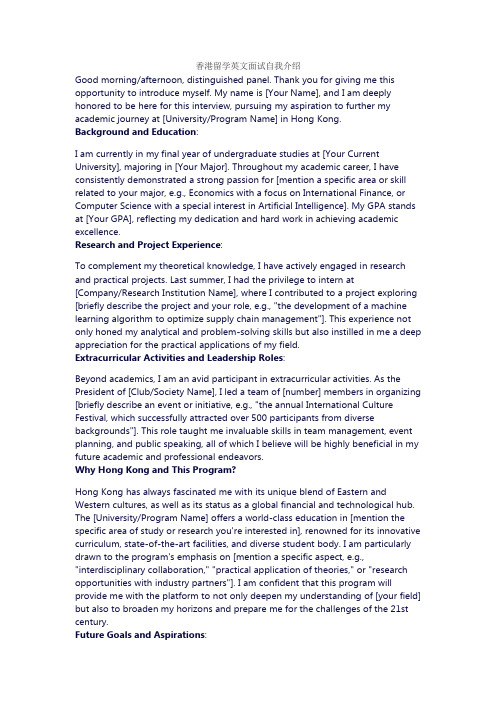
香港留学英文面试自我介绍Good morning/afternoon, distinguished panel. Thank you for giving me this opportunity to introduce myself. My name is [Your Name], and I am deeply honored to be here for this interview, pursuing my aspiration to further my academic journey at [University/Program Name] in Hong Kong.Background and Education:I am currently in my final year of undergraduate studies at [Your Current University], majoring in [Your Major]. Throughout my academic career, I have consistently demonstrated a strong passion for [mention a specific area or skill related to your major, e.g., Economics with a focus on International Finance, or Computer Science with a special interest in Artificial Intelligence]. My GPA stands at [Your GPA], reflecting my dedication and hard work in achieving academic excellence.Research and Project Experience:To complement my theoretical knowledge, I have actively engaged in research and practical projects. Last summer, I had the privilege to intern at [Company/Research Institution Name], where I contributed to a project exploring [briefly describe the project and your role, e.g., "the development of a machine learning algorithm to optimize supply chain management"]. This experience not only honed my analytical and problem-solving skills but also instilled in me a deep appreciation for the practical applications of my field.Extracurricular Activities and Leadership Roles:Beyond academics, I am an avid participant in extracurricular activities. As the President of [Club/Society Name], I led a team of [number] members in organizing [briefly describe an event or initiative, e.g., "the annual International Culture Festival, which successfully attracted over 500 participants from diverse backgrounds"]. This role taught me invaluable skills in team management, event planning, and public speaking, all of which I believe will be highly beneficial in my future academic and professional endeavors.Why Hong Kong and This Program?Hong Kong has always fascinated me with its unique blend of Eastern and Western cultures, as well as its status as a global financial and technological hub. The [University/Program Name] offers a world-class education in [mention the specific area of study or research you're interested in], renowned for its innovative curriculum, state-of-the-art facilities, and diverse student body. I am particularly drawn to the program's emphasis on [mention a specific aspect, e.g., "interdisciplinary collaboration," "practical application of theories," or "research opportunities with industry partners"]. I am confident that this program will provide me with the platform to not only deepen my understanding of [your field] but also to broaden my horizons and prepare me for the challenges of the 21st century.Future Goals and Aspirations:Upon completion of my studies, I aspire to [briefly describe your career goals, e.g., "work as a financial analyst in a top multinational corporation, leveraging my skills in data analysis and problem-solving to drive business growth"] or [if pursuing further studies, "pursue a Ph.D. in [field], with the ultimate goal of contributing to groundbreaking research that can positively impact society"]. I believe that the knowledge and experiences I will gain from this program will be instrumental in helping me achieve these goals.In conclusion, I am excited about the prospect of joining the [University/Program Name] community and contributing to its vibrant academic life. Thank you again for considering my application. I look forward to the opportunity to discuss further how I can contribute to and benefit from this esteemed institution.。
爱因斯特(IAESTE)国际大学生实习交流项目2018-2020
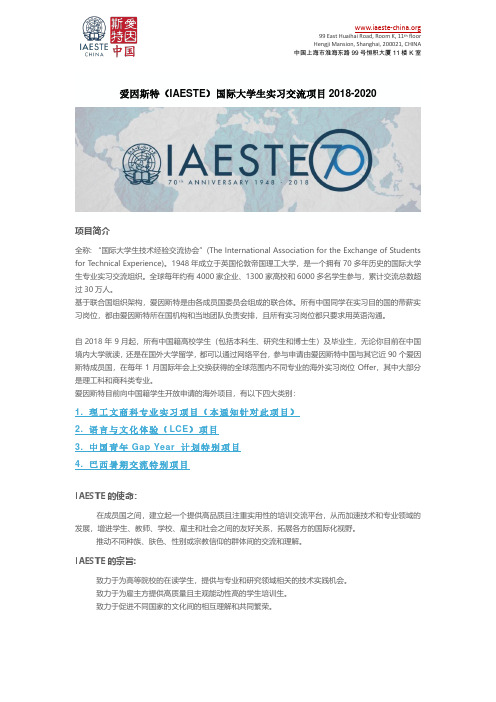
爱因斯特(IAESTE)国际大学生实习交流项目2018-2020项目简介全称: “国际大学生技术经验交流协会”(The International Association for the Exchange of Students for T echnical Experience)。
1948年成立于英国伦敦帝国理工大学,是一个拥有70多年历史的国际大学生专业实习交流组织。
全球每年约有4000家企业、1300家高校和6000多名学生参与,累计交流总数超过30万人。
基于联合国组织架构,爱因斯特是由各成员国委员会组成的联合体。
所有中国同学在实习目的国的带薪实习岗位,都由爱因斯特所在国机构和当地团队负责安排,且所有实习岗位都只要求用英语沟通。
自2018年9月起,所有中国籍高校学生(包括本科生、研究生和博士生)及毕业生,无论你目前在中国境内大学就读,还是在国外大学留学,都可以通过网络平台,参与申请由爱因斯特中国与其它近90个爱因斯特成员国,在每年1月国际年会上交换获得的全球范围内不同专业的海外实习岗位Offer,其中大部分是理工科和商科类专业。
爱因斯特目前向中国籍学生开放申请的海外项目,有以下四大类别:IAESTE的使命:在成员国之间,建立起一个提供高品质且注重实用性的培训交流平台,从而加速技术和专业领域的发展,增进学生、教师、学校、雇主和社会之间的友好关系,拓展各方的国际化视野。
推动不同种族、肤色、性别或宗教信仰的群体间的交流和理解。
IAESTE的宗旨:致力于为高等院校的在读学生,提供与专业和研究领域相关的技术实践机会。
致力于为雇主方提供高质量且主观能动性高的学生培训生。
致力于促进不同国家的文化间的相互理解和共同繁荣。
项目网址:/项目官方微信:IAESTE-China选拔范围:●学历要求:在读大二及以上本科生(转专业至18级可申请);●专业范围:1.数学统计及计算机类专业;2.通讯工程及计算机类专业;3.电气与电子工程类;4.生态环境工程类;5.物理、化学、生物等理科类;6.商业管理等文商科类;7.机械工程及材料类;●语言要求:⏹工作语言均为英语,申请英语母语国家的要求是大学英语六级/雅思6.0;申请非英国家的要求是大学英语四级/雅思5.5。
阿博留学全面介绍格拉健康应用技术大学
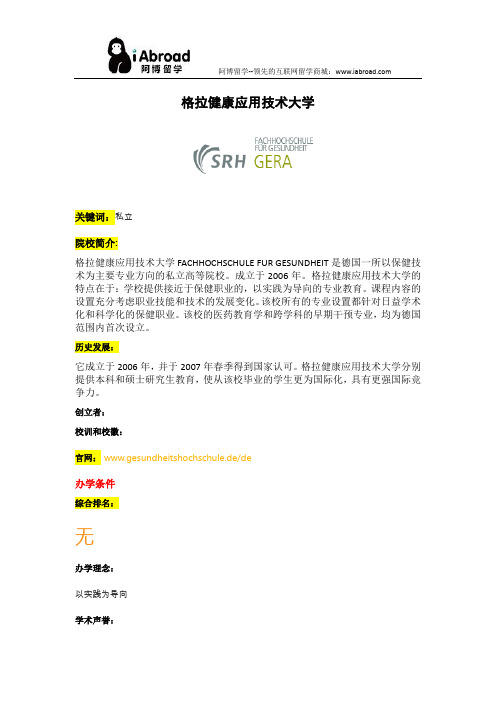
格拉健康应用技术大学关键词:私立院校简介:格拉健康应用技术大学FACHHOCHSCHULE FUR GESUNDHEIT是德国一所以保健技术为主要专业方向的私立高等院校。
成立于2006年。
格拉健康应用技术大学的特点在于:学校提供接近于保健职业的,以实践为导向的专业教育。
课程内容的设置充分考虑职业技能和技术的发展变化。
该校所有的专业设置都针对日益学术化和科学化的保健职业。
该校的医药教育学和跨学科的早期干预专业,均为德国范围内首次设立。
历史发展:它成立于2006年,并于2007年春季得到国家认可。
格拉健康应用技术大学分别提供本科和硕士研究生教育,使从该校毕业的学生更为国际化,具有更强国际竞争力。
创立者:校训和校徽:官网:www.gesundheitshochschule.de/de办学条件综合排名:无办学理念:以实践为导向学术声誉:于2007年春季得到国家认可。
格拉健康应用技术大学分别提供本科和硕士研究生教育,使从该校毕业的学生更为国际化,具有更强国际竞争力。
知名人物:知名华人:特色学制:学校提供接近于保健职业的,以实践为导向的专业教育。
课程内容的设置充分考虑职业技能和技术的发展变化。
师资力量:优秀教师众多,已经培养了为数众多的优秀毕业生。
该校所有的专业设置都针对日益学术化和科学化的保健职业。
该校的医药教育学和跨学科的早期干预专业,均为德国范围内首次设立。
硬件设备:语言中心和新的资料中心极大地为语言学习的各方面提供了帮助。
学校体育设施优良。
校园生活(图文形式呈现)校园环境:该校所有的专业设置都针对日益学术化和科学化的保健职业。
该校的医药教育学和跨学科的早期干预专业,均为德国范围内首次设立。
气候状况:年平均气温8摄氏度,冬季气温在零下2摄氏度到2摄氏度之间,夏季气温在14摄氏度到24摄氏度之间。
年降雨量为500毫米本土生活:图林根除了富有魅力的自然景色外,它的许多中世纪的城镇称得上是名副其实的文化圣地。
英国游学留学国际语言学校之EF伊斯特本校区介绍

伊斯特本(Eastbourne),英国英格兰东南区域东萨塞克斯郡最大的镇、自治市镇。
当地自从石器时代已经有人类活动,但直到19世纪仍然是个由四个小村落合并成的小市镇。
籍著铁路的发展,伊斯特本成了一个原始维多利亚式的度假区。
伊斯特本的「阳光海岸」沙滩和它靠近伦敦的地理位置,使其成为英格兰最时髦的度假胜地之一。
悠闲的咖啡馆和热闹的俱乐部现场吸引着国游客,它也是帆船、帆板、骑马或在陡峭的海边悬崖间徒步旅行的理想目的地。
如果你不喜欢游客聚集的大城市,又想感受海滨英伦小镇的风情,那就来吧。
1.在伊斯特本国际语言学校体验语言环境与文化的多样性伊斯特本校区有来自五大洲的学生们,在这里你将和这些异国伙伴组成不多于17人的国际化小班,感受浓厚的多文化氛围,得到更多开口说英语的机会。
360度的全英语小班课堂相信学外语的你,肯定遭遇过这样的尴尬:听老师上课说着挺好,转头就忍不住和身边的小伙伴说起了中文...然而在我们的海外校区,你不会有这样「偷懒」的机会,因为你身边的小伙伴,几乎都是外国人!出发前和到达校区的第一天,你将接受全面的英语水平分班测试,然后进入最适合你水平的班级学习。
每个班的中国学生一般不超过两个,外教还会特意分开你和TA的座位,使你不得不与外国同学多说话。
在这个过程中你将逐渐提升外语自信度,并加强语言运用的能力。
课堂中使用的教材,由我们联合剑桥大学、语言专家们根据游学特性量身编制,不再是枯燥无趣的背单词、记语法,你会体验到形式多样的上课方式。
Presentation、Role Play、Questionaire Survey......甚至还会写剧本、编歌词,在和同学们玩各种游戏的过程中,身体力行地学习、运用外语。
课程结束时,通过再次测试,你将获得一份证明了你进步的结业证书。
不止是语言外语课程主要课程:每周26节课,将从课堂里学到的语言技能运用于海外生活,从而获得对语言能力的深入理解及掌握。
通过分组学习,互动性课堂,项目设计以及个性化课程,会逐步拥有扎实的,最大化的语言能力进步。
云南财经大学与新西兰商学院“3+1学分互认项目相关情况介绍

财经大学与新西兰X学院“31"学分互认项目相关情况介绍★项目进展情况:财经大学2021年10月派出首批新西兰X学院31学分互认项目学生3人,现已通过高级英语课程考试,进入专业课学习.预计在2021年12月获得新西兰X学院七级本科证书,免雅思直升新西兰林肯大学攻读硕士(15个月)。
2021年1月18至2月16日,财经大学派出首批赴新西兰X学院游学团。
游学团成员们在新西兰进行国际英语强化学习、参观企业和浏览新西兰南岛,收获颇多。
★NZCBinfo |2021新西兰X学院&林肯大学商学升本升硕学位手册://mp.weixin.。
/s?__biz=MzA3NT3NTgwNA==&mid=204342355&idx=1&sn=c99b369657d496bce5e55a8e8f9ea0bd&s cene=0#rd★圆梦新西兰――不用死磕雅思也能直升名校(NZCB)作为新西兰第五大出口,每年有8万多国际学生在新西兰留学,截止2021年前两个学期,国际教育的总产值已达28.5亿纽币.然而,一边是海外教育蓬勃,另外一边却是留学生们遭遇的困境。
毕竟,留学看似美好,语言关却难过—-对于不少怀揣着留学梦的学生们来说,语言是横亘在我们与理想学府之间的一道无法绕开的壁垒。
而在来到一个陌生的国度后,语言也是我们了解不同文化、融入当地的最重要“法宝”。
你曾经有过因为雅思差0.5分而被梦想的学校拦在门外的郁闷时刻吗?你知道,其实不用和雅思“殊死搏斗”也能进名校吗?我就是一个成功案例,我现在是坎特伯雷大学商学系主修金融会计专业的一名本科生,我很高兴与大家分享我的入学途径。
“新西兰X学院可以为留学生们提供最便捷有效的途径,帮助大家在最短的时间内提高英语水平,并打好专业基础,直升自己心中理想的大学."这就是我要告诉大家的途径!新西兰X学院是全新西兰唯一的IESOL考点。
这个考试被承认可入学专科、本科和研究生,可以让学生无需再考雅思,即可直升林肯大学、梅西大学、坎特伯雷大学等,这个考试备受留学生们欢迎。
上海市浦东新区2021届高三上学期一模英语试题含解析

18. A. His flight number and arrival time.
B. The cause of the flight's late arrival.
C. The number of his luggage check.
D. It can create smells and give them off to any scene.
15. A. It helps shoppers locate the right brand of perfume.
B. It helps shoppers check out the perfumes before they buy.
阅读下面短文,在空白处填入1个适当的单词或括号内单词的正确形式。
Since astronomers confirmed the presence of planets beyond our solar system, called exoplanets, humans_________1_________(wonder) how many could harbor life.
Our galaxy holds at least an______4______(estimate) 300 million of these potentially habitable worlds, based on even the most conservative interpretation of the results in a new study to be published in The Astronomical Journal.
德国哥廷根大学基本概况
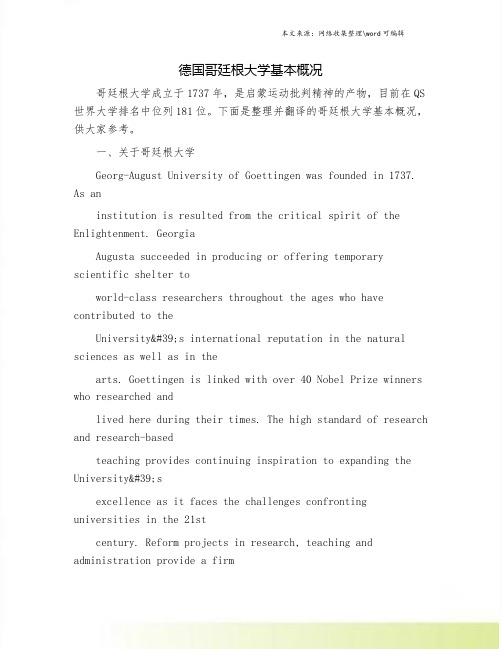
德国哥廷根大学基本概况哥廷根大学成立于1737年,是启蒙运动批判精神的产物,目前在QS 世界大学排名中位列181位。
下面是整理并翻译的哥廷根大学基本概况,供大家参考。
一、关于哥廷根大学Georg-August University of Goettingen was founded in 1737. As aninstitution is resulted from the critical spirit of the Enlightenment. GeorgiaAugusta succeeded in producing or offering temporary scientific shelter toworld-class researchers throughout the ages who have contributed to theUniversity's international reputation in the natural sciences as well as in thearts. Goettingen is linked with over 40 Nobel Prize winners who researched andlived here during their times. The high standard of research and research-basedteaching provides continuing inspiration to expanding the University'sexcellence as it faces the challenges confronting universities in the 21stcentury. Reform projects in research, teaching and administration provide a firmbasis for the future.哥廷根大学成立于1737年,是启蒙运动批判精神的产物。
Espressif Systems (Shanghai) Co.,Ltd.产品说明书
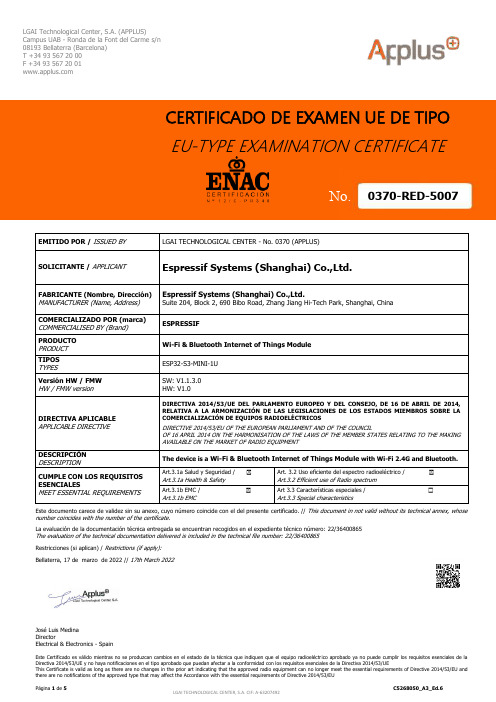
EMITIDO POR / ISSUED BYLGAI TECHNOLOGICAL CENTER - No. 0370 (APPLUS)SOLICITANTE / APPLICANTEspressif Systems (Shanghai) Co.,Ltd.FABRICANTE (Nombre, Dirección)MANUFACTURER (Name, Address) Espressif Systems (Shanghai) Co.,Ltd.Suite 204, Block 2, 690 Bibo Road, Zhang Jiang Hi-Tech Park, Shanghai, China COMERCIALIZADO POR (marca)COMMERCIALISED BY (Brand) ESPRESSIFPRODUCTOPRODUCT Wi-Fi & Bluetooth Internet of Things Module TIPOSTYPESESP32-S3-MINI-1U Versión HW / FMWHW / FMW versionSW: V1.1.3.0HW: V1.0DIRECTIVA APLICABLEAPPLICABLE DIRECTIVEDIRECTIVA 2014/53/UE DEL PARLAMENTO EUROPEO Y DEL CONSEJO, DE 16 DE ABRIL DE 2014, RELATIVA A LA ARMONIZACIÓN DE LAS LEGISLACIONES DE LOS ESTADOS MIEMBROS SOBRE LA COMERCIALIZACIÓN DE EQUIPOS RADIOELÉCTRICOSDIRECTIVE 2014/53/EU OF THE EUROPEAN PARLIAMENT AND OF THE COUNCILOF 16 APRIL 2014 ON THE HARMONISATION OF THE LAWS OF THE MEMBER STATES RELATING TO THE MAKING AVAILABLE ON THE MARKET OF RADIO EQUIPMENTDESCRIPCIÓNDESCRIPTIONThe device is a Wi-Fi & Bluetooth Internet of Things Module with Wi-Fi 2.4G and Bluetooth.CUMPLE CON LOS REQUISITOS ESENCIALESMEET ESSENTIAL REQUIREMENTSArt.3.1a Salud y Seguridad / ☒Art.3.1a Health & SafetyArt. 3.2 Uso eficiente del espectro radioeléctrico / ☒Art.3.2 Efficient use of Radio spectrumArt.3.1b EMC / ☒Art.3.1b EMC Art 3.3 Características especiales / ☐Art.3.3 Special characteristicsEste documento carece de validez sin su anexo, cuyo número coincide con el del presente certificado. // This document in not valid without its technical annex, whosenumber coincides with the number of the certificate.La evaluación de la documentación técnica entregada se encuentran recogidos en el expediente técnico número: 22/36400865The evaluation of the technical documentation delivered is included in the technical file number: 22/36400865Restricciones (si aplican) / Restrictions (if apply):Bellaterra, 17 de marzo de 2022 // 17th March 2022José Luis Medina DirectorElectrical & Electronics - SpainEste Certificado es válido mientras no se produzcan cambios en el estado de la técnica que indiquen que el equipo radioeléctrico aprobado ya no puede cumplir los requisitos esenciales de la Directiva 2014/53/UE y no haya notificaciones en el tipo aprobado que puedan afectar a la conformidad con los requisitos esenciales de la Directiva 2014/53/UEThis Certificate is valid as long as there are no changes in the prior art indicating that the approved radio equipment can no longer meet the essential requirements of Directive 2014/53/EU and No.0370-RED-5007LGAI Technological Center, S.A. (APPLUS)Campus UAB - Ronda de la Font del Carme s/n 08193 Bellaterra (Barcelona) T +34 93 567 20 00 F +34 93 567 20 01 No.CERTIFICADO DE EXAMEN UE DE TIPOEU-TYPE EXAMINATION CERTIFICATEF +34 93 567 20 01Anexo técnico Ed. 117/03/2022ANEXO TÉCNICOTECHNICAL ANNEX0370-RED-5007L G A I T e c h n o l o g i c a l C e n t e r , S .A . C .I .F A 63207492A. MODEL DESCRIPTIONA.1. GENERAL INFORMATION ON THE RADIO EQUIPMENT:Manufacturing country: China Brand: ESPRESSIFCommercial designation: ESPRESSIFCountry of commercialization: European UnionRadio service: Wi-Fi 2.4G and BluetoothApplication: Wi-Fi & Bluetooth Internet of Things ModuleA.1.1 TRADE VERSIONS/VARIANTS: ESP32-S3-MINI-1UA.2. FEATURES: Wi-Fi & Bluetooth Internet of Things ModuleA.3. SOFTWARE VERSION(S): V1.1.3.0A.4. HARDWARE VERSION(S): V1.0A.5. OTHER COMPONENTS- Disposable antenna YES ☐ NO ☒o Antenna gain (dBi)*:(*) only in case of YESF +34 93 567 20 01Anexo técnico Ed. 117/03/2022ANEXO TÉCNICOTECHNICAL ANNEX0370-RED-5007L G A I T e c h n o l o g i c a l C e n t e r , S .A . C .I .F A 63207492A.6. OPERATING FREQUENCIES AND MAXIMUM POWER EMITTED BY BANDN/A: Not applicable N/D: Not defined* Conducted power for mobile technologies and EIRP for other technologies.A.7. OTHER PARAMETERS OF RADIO INTERFACE SPECIFICATIONS (RI)Requires license/Use authorization: YES ☐ NO ☒BAND SERVICEOPERATIONAL FREQUENCY(TX)MAX POWER* CNAF IR CNAF/ UN-XXX Band 1 BLE F_min: 2402MHz F_max: 2480MHz 9.25 dBm IR-163 UN-85 Band 2WiFi 2.4GHzF_min: 2412MHz F_max: 2472MHz19.95 dBmIR-163UN-85F +34 93 567 20 01Anexo técnico Ed. 117/03/2022ANEXO TÉCNICOTECHNICAL ANNEX0370-RED-5007L G A I T e c h n o l o g i c a l C e n t e r , S .A . C .I .F A 63207492B. TEST PROTOCOLREQUIREMENT STANDARDLaboratory Report no. Health and Safety (Article 3.1a) EN IEC 62368-1:2020+A11:2020 TA Technology(Shanghai) Co., Ltd. R2112A1105-L1 EN 50665:2017 R2112A1105-M1 EN IEC 62311:2020 EMC (Article 3.1b) EN 301 489-1 V2.2.3 TA Technology(Shanghai) Co., Ltd.R2112A1105-E1EN 301 489-17 V3.2.4EN 55032:2015+A11:2020 EN 55035:2017+A11:2020 Radio Aspects (Article 3.2) EN 300 328 V2.2.2TA Technology(Shanghai) Co., Ltd.R2112A1105-R1C. RESTRICTIONSRestrictions: YES ☐ NO ☒ Describe restrictions: N/AF +34 93 567 20 01Anexo técnico Ed. 117/03/2022ANEXO TÉCNICOTECHNICAL ANNEX0370-RED-5007L G A I T e c h n o l o g i c a l C e n t e r , S .A . C .I .F A 63207492D. ACTIVITIES CARRIED OUT BY THE NBTechnical Documentation Review☐ Assembly drawings(s) ☒ Block diagram ☒ Circuit diagram/schematics ☒ External photographs ☒ Label drawing/location ☒ User manual ☒ Internal photographs ☒ Operational description ☒ Risk Assessment☒ Test set-up photographs☒ Test reports ☒ EU declaration of conformity ☒ Bill of materials☒ PCB layout☐ Installation diagrams and explanations☒ List of applied (harmonized and non-harmonized) standardsOther activities☒ RIS☒ EFIS/CNAF☒ Review Technical Justifications ☒ Analysis report☒ EU type certification issuedE.ADDITIONAL INFORMATION:Radio Equipment Directive 2014/53/EU, Article 10.4: Manufacturers shall keep the technical documentation and the EU declaration of conformity for 10 years after the radio equipment has been placed on the market.Radio Equipment Directive 2014/53/EU, Annex III, Module B.7: The manufacturer shall inform the notified body that holds the technical documentation relating to the EU-type examination certificate of all modifications to the approved type that may affect the conformity of the radio equipment with the essential requirements of this Directive or the conditions for validity of that certificate. Such modifications shall require additional approval in the form of an addition to the original EU-type examination certificate.This review includes draft standards, deviations from the standards and technical justification for compliance.。
《医疗质量评估与监测》个人学习笔记

《医疗质量评估与监测》导读一、关于Avedis DonabedianAvedis Donabedian(1919-2000)出生于黎巴嫩贝鲁特一个亚美尼亚家庭,他的父亲是当地的一位普通医生,他毕业于贝鲁特美洲大学,并于1919年1月7日在美国哈佛大学获得公共健康硕士学位。
在纽约医学院从事了一段时间的教学工作之后,他于1961年成为密歇根大学公共健康学院的教师。
他曾是美国国家科学院特别院士、英国皇家医学院荣誉院士、墨西哥国家医学院荣誉院士。
Avedis Donabedian通过近20年的研究,建立了西方现代医疗质量研究的基石,Avedis Donabedian是美国医疗质量管理的先驱,因其在医疗质量领域的卓越贡献,被誉为“医疗质量评估之父”,他的理论框架和研究方法对全球医疗质量管理和改进产生了深远影响。
2000年11月9日,Avedis Donabedian走完他81岁的一生,世界卫生组织称“国际公共卫生界失去了一位真正的巨人”。
二、内容概述《医疗质量评估与监测》是由美国医疗质量管理之父Avedis Donabedian所著的三卷学术巨著,被视为医疗质量领域的“圣经”。
这本书是Donabedian近20年研究成果的结晶,它首次系统、全面地对医疗质量概念和评估方法进行了理论上的探索,并通过大规模实证研究提供了丰富的证据。
书中建立的理论框架成为西方现代医疗质量研究的基石,已经被翻译成多种文字。
三、基本内容《医疗质量评估与监测》第一部分主要探讨了医疗质量的理论问题。
通过构筑医疗质量的“统一模型”,该书将医疗成本、病人获益以及提供服务的相关风险纳入统一的医疗质量范畴内。
书中澄清了医疗质量的基本概念和相关定义,并进一步发展和完善了“结构-过程-结果”三维理论体系。
第二部分则深入分析了建立医疗质量评估准则和标准的各个方面问题。
这部分内容不仅涉及医疗质量的评估方法,还包括医疗质量改进策略。
书中提出了多种评估指标和改进措施,旨在帮助医疗机构提高服务质量,保障患者安全,提升患者满意度,并促进医疗机构的可持续发展。
2017年日内瓦商学院校园介绍
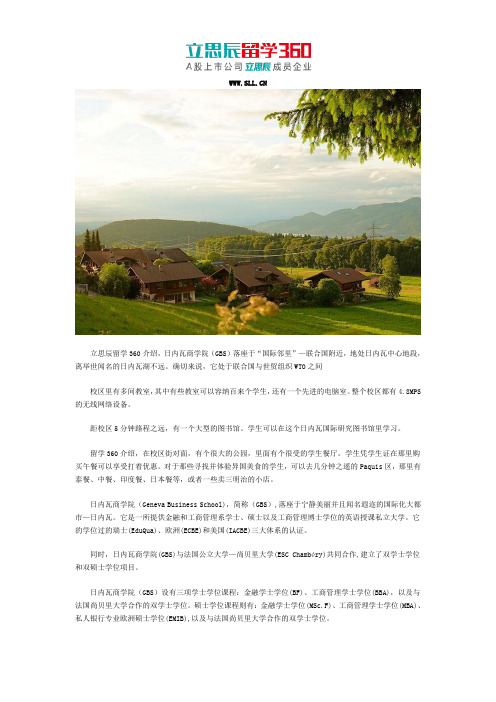
立思辰留学360介绍,日内瓦商学院(GBS)落座于“国际邻里”—联合国附近,地处日内瓦中心地段,离举世闻名的日内瓦湖不远。
确切来说,它处于联合国与世贸组织WTO之间
校区里有多间教室,其中有些教室可以容纳百来个学生,还有一个先进的电脑室。
整个校区都有4.8MPS 的无线网络设备。
距校区5分钟路程之远,有一个大型的图书馆。
学生可以在这个日内瓦国际研究图书馆里学习。
留学360介绍,在校区街对面,有个很大的公园,里面有个很受的学生餐厅。
学生凭学生证在那里购买午餐可以享受打着优惠。
对于那些寻找并体验异国美食的学生,可以去几分钟之遥的Paquis区,那里有泰餐、中餐、印度餐、日本餐等,或者一些卖三明治的小店。
日内瓦商学院(Geneva Business School),简称(GBS),落座于宁静美丽并且闻名遐迩的国际化大都市—日内瓦。
它是一所提供金融和工商管理系学士、硕士以及工商管理博士学位的英语授课私立大学。
它的学位过的瑞士(EduQua)、欧洲(ECBE)和美国(IACBE)三大体系的认证。
同时,日内瓦商学院(GBS)与法国公立大学—尚贝里大学(ESC Chambéry)共同合作,建立了双学士学位和双硕士学位项目。
日内瓦商学院(GBS)设有三项学士学位课程:金融学士学位(BF)、工商管理学士学位(BBA),以及与法国尚贝里大学合作的双学士学位。
硕士学位课程则有:金融学士学位(MSc.F)、工商管理学士学位(MBA)、私人银行专业欧洲硕士学位(EMIB),以及与法国尚贝里大学合作的双学士学位。
AsianHedgeFundsATaleofThree:亚洲对冲基金的一个故事,三

Asian Hedge Funds: A Tale of Three CitiesMELVYN TEO1The hedge fund industry in Asia is dominated by a trio of financial centres: Hong Kong, Singapore, and Sydney. In this inaugural issue of the statistical digest, we provide a broad overview of the hedge fund industry in Asia and zero in on issues relevant to investors. Our analysis will be organized along the lines of manager location. Accordingly, we ask the following questions: How are hedge fund assets deployed across the three centres? What investment strategies do these assets partake in? Does the risk-adjusted performance of those assets differ across centres? To shed light on these issues, we employ fund return, assets under management, and characteristics data from the merged May 2007 Eurekahedge and Asiahedge database2.I. SIZE, STYLE, AND INVESTMENT REGION DISTRIBUTION1 Melvyn Teo is Assistant Professor of Finance and Director, BNP Paribas Hedge Fund Centre at the Singapore Management University. E-mail: *****************.sg. Phone: +65-6828-0735. Chuin-Hao Lim provided excellent research assistance. I thank Peter Douglas, Luz Foo, and Narayan Naik for comments. The views expressed here are my own and do not represent those of BNP Paribas or Singapore Management University.2 There are 888 live and dead Asian focused funds (Asia ex Japan, Asia incl Japan, Japan, Australia/New Zealand, Greater China, India, Korea, and Taiwan) in the May 2007 Eurekahedge database. By merging with the Asiahedge database, we include an additional 293 Asian focused funds. The characteristics data, e.g., size and fees, are valid as of April 2007. Future issues of the digest will analyze hedge fund data from other data sources as well.To get the ball rolling, we plot in Figure 1 the distribution of hedge funds by assets under management3 (henceforth AUM) for the three financial centres.4 We group funds into the following US dollar size categories: 0-10m, 10-50m, 50-100m, 100-500m, and 500m+. Clearly from Figure 1, the size distribution is fairly similar across centres. The main difference is that Singapore and Sydney attract a larger proportion of smaller funds (0-10m and 10-50m funds) while Hong Kong draws a larger proportion of bigger funds (100-500m funds). That said, Sydney has the highest proportion of funds in the largest size category (500m+ funds) reflecting the significant variation in the size of hedge funds managed from Sydney. The difference in size distribution between Hong Kong and Singapore hedge funds is consistent with the regulatory differences between the two countries.There are also interesting differences in the investment style distribution of funds across centres. In Figure 2, we plot the distribution of hedge funds according to investment style. We find that in Hong Kong, most 3 To the extent that funds list on databases for marketing reasons, all commercial databases (including Eurekahedge and Asiahedge) are likely to underestimate the number of very large funds.4 We assume that funds managed from Australia are managed from Sydney. In reality funds managed from Australia are located mostly in Sydney and Melbourne. Funds in Sydney comprise about three-quarters of all funds managed from Australia (according to the Asiahedge database). Unlike Asiahedge, Eurekahedge does not include city information in the manager location field.of the funds (58%) are Equity Long/Short funds. In contrast, there is a greater diversity of funds in Singapore and Sydney. Specifically, Sydney has a preponderance of CTA funds, while Singapore has a disproportionate number of Macro funds. These results reflect the presence of significant opportunities for Equity Long/Short funds in the Greater China market, the importance of commodities to the Australian economy, and the dominance of Singapore as a currency trading hub.Figure 3: Distribution of funds by investment geographyTo further investigate their investment opportunity set, we also stratify funds by investment geography. The pie chart in Figure 3 presents the distribution of funds based on the location of their investment markets. Not surprisingly, for geographical proximity reasons, we find that most hedge funds investing in Greater China are managed from Hong Kong and all funds investing in Australia/New Zealand are managed from Sydney. Sydney also has the highest proportion of Global funds (38%) while Singapore has the highest proportion of Japan funds (14%). The higher proportion of Japan funds operating from Singapore versus Hong Kong seems puzzling given the proximity of the latter to Tokyo. One view is that married Japanese expatriates are attracted to the family friendly living conditions in Singapore.II. FACTOR AND CORRELATION ANALYSISFigure 4: Heat map of hedge fund portfolio and principal component R-squares0.10.20.30.40.50.60.70.80.91Next we probe deeper and investigate the drivers underlying hedge fund returns and whether those drivers vary for funds operating in the same investment style and geography, but managed from different centres. Principal components analysis is a convenient tool for summarizing the main factors driving portfolio returns. We use principal components analysis to derive the main components or factors driving hedge fund portfolios. To start, the equity-weighted hedge fund portfolios we analyze are investment style and geography intersections (e.g., Equity Long/Short, Asia ex Japan). Altogether we have 11 style and geography intersections with sufficient funds to form portfolios. To these we add the group of CTAs and Macro funds managed from the three centres. With the 13 hedge fund portfolios 5, we can derive 13 principal components or factors.The heat map in Figure 4 illustrates the R-squares of the top ten components (based on explanatory power) relative to the hedge fund portfolios. That is, the heat map shows how well each component explains the variation in returns for each hedge fund style/geography portfolio in a linear regression setting. A darker cell in Figure 4 indicates that the principal component better explains variation in the corresponding hedge fund portfolio’s returns.The colors of the cells in Figure 4 suggest that return variation in hedge funds is driven more by investment style than investment geography. For instance, the principal component that best explains Equity Long/Short funds is P1 regardless of the geographical region. P2, P6, and P8 are the factors driving Macro, CTA, and distressed funds, respectively. Only multi-strategy funds seem to be explained by a variety of factors corresponding to different investment markets.5The sample period is from January 1998 to March 2007, unless noted otherwise.Figure 5: Heat map of hedge fund portfolio and benchmark correlations10.80.60.40.2-0.2 Having analyzed the broad differences in factors across investment style/geography intersections, we now turn to differences within those intersections. Given the preponderance of Equity Long/Short funds in the region, we focus on this investment style to ensure that each style/geography/manager location intersection has sufficient funds for the construction of portfolio returns. We report in heat map form the correlations between hedge fund portfolios. We also report the correlations of those portfolios with various equity benchmarks: Nikkei 225, MSCI Asia, MSCI Asia ex Japan, and MSCI China.The heat map in Figure 5 depicts a rich pattern of correlations. It indicates that Asia ex Japan and Asia incl Japan hedge funds managed from Sydney are less correlated than their hedge fund counterparts managed from Singapore and Hong Kong. The same can be said of Japan hedge funds managed from Singapore. One reason for this, at least for Asia incl Japan hedge funds managed from Sydney and Japan hedge funds managed from Singapore, is that they are less exposed to their corresponding equity markets, i.e., as proxied by the MSCI Asia and Nikkei 225 indices, respectively. Overall, based on the correlations between the Equity Long/Short hedge fund portfolios and equity benchmark returns, Equity Long/Short hedge funds seem fairly well-explained by their respective equity benchmarks. This also suggests that the P1 principal component featured in Figure 4, which well-explains Asian Equity Long/Short style returns, is an Asian equity factor.ANALYSISIII. PERFORMANCENext, to compare hedge fund alpha of Equity Long/Short funds, we measure performance relative to the corresponding equity indices: Nikkei 225, MSCI Asia, and MSCI Asia ex Japan.6 We exclude Greater China funds from the analysis since there are no Equity Long/Short Greater China funds in Singapore and Sydney. We also include funds from US/UK to explore the return differential between Asian funds investing from Asia and Asian funds investing from distant locations (US and UK). For robustness, we investigate both the cross-sectional distribution of hedge fund alpha as well as the performance of fund portfolios stripped of their return covariation with equities. 7Figure 6 graphs the distribution of fund alpha for Equity Long/Short funds with at least 30 months of return observations. The funds are grouped by manager location. The difference in alphas between nearby (Hong Kong, Singapore, and Sydney) and distant (US and UK) funds is highly suggestive of a local informational advantage. On average Asian Equity Long/Short funds managed from the US/UK underperform Asian Equity Long/Short funds managed from Hong Kong, Singapore, and Sydney by about 6.79% per year or 0.494% per month. This difference is statistically significant at the 1% level. Within Asian managed funds, Hong Kong and Sydney funds seem to deliver somewhat superior performance due to the presence of some stellar funds in the right tail of the alpha distribution. However the difference in performance between Hong Kong (or Sydney) managed funds and Singapore managed funds is statistically insignificant at the 5% level.Figure 6: Cross-sectional distribution of6 The factor model that we use to adjust for risk is the CAPM. The market factors we use for Japan, Asia ex Japan, and Asia incl Japan funds are the return on the Nikkei 225 Index, the return on the MSCI Asia ex Japan index, and the return on the MSCI Asia index, respectively. To find beta, the excess return on the fund portfolio is regressed on a constant and the excess return on the market. Excess returns are returns in excess of the risk free rate which is taken off Kenneth French’s website.7 Note that hedge fund returns from databases are likely to be affected by various database induced biases including survivorship bias, backfill bias, incubation bias, and liquidation bias. Since our data samples include both dead and live funds, survivorship bias is minimized. Our results on a local information advantage hold to the extent that these biases affect both the nearby and distant fund portfolios equally.In Figure 7, we breakdown the analysis by investment geography (Asia ex Japan, Asia incl Japan, and Japan) and plot the cumulative risk-adjusted returns of the style/geography/manager location intersections. We find that the underperformance of US/UK funds persists for all three geographical regions. The equal-weighted portfolio of funds managed from Hong Kong, Singapore, and Sydney outperforms the equal-weighted portfolio of funds managed from the US/UK by 3.90%, 2.22%, and 3.55% per year for funds investing in Asia ex Japan, Asia incl Japan, and Japan, respectively. Further, the difference in means is statistically significant at the 5% level for funds investing in Asia ex Japan and Japan.Also, within Asia, the over performance of Hong Kong funds is confined to the Asia ex Japan and Asia incl Japan regions. One view is that the geographical proximity of Hong Kong to mainland China allows Asia focused funds in Hong Kong to better take advantage of the attractive investment opportunities in China, a large emerging economy. For example, fund managers based in Hong Kong can better gauge the economic prospects of Chinese firms by visiting upstream (suppliers) and downstream firms (consumers) in China.Figure 7: Cumulative market-adjusted returns by manager locationIV. SUMMARYIn this issue of the statistical digest, we have used a fairly unique lens to view hedge funds: manager location. We uncover differences in size, investment strategies, and investment geography between funds managed from Hong Kong, Singapore, and Sydney. Funds managed from Hong Kong tend to be Equity Long/Short funds between US$100m to US$500m in size. Funds in Singapore tend to be smaller while funds in Sydney demonstrate significant variation in assets under management. Sydney attracts a disproportionate number of CTA funds while Singapore attracts a disproportionate number of Macro and Japan focused funds.We also show that there are systematic differences in risk exposures between funds managed from the three centres. Asia ex Japan and Asia incl Japan Equity Long/Short funds managed from Sydney tend to have lower market exposures relative to other Asian funds. Similarly, Japan focused Equity Long/Short funds managed from Singapore tend to have a lower exposure to the Nikkei 225 index relative to other Japan focused funds.Finally, our performance analysis reveals that funds managed from Asia outperform funds managed from the US and the UK. A local informational advantage manifests in Asia and this translates to differences in risk-adjusted returns between nearby and distant fund portfolios of around 2 and 4% per year.8 While Asian Equity Long/Short funds managed from Hong Kong outperform those managed from Singapore and Sydney, we hypothesize that some of the over performance may be driven by Hong Kong’s geographical proximity to China. These results are relevant to hedge fund investors considering an allocation to Asia.8 Note that our results cannot be explained by the effects of AUM on fund returns. Some industry practitioners argue that diseconomies of scale exist in the hedge fund industry. We have monthly AUM information for the Eurekahedge database and can empirically test this hypothesis for Eurekahedge Asian Equity Long/Short hedge funds. We estimate a Fama and MacBeth (Journal of Political Economy, 1973) cross-sectional regression of month t fund returns (dependent variable) on month t-1 fund AUM (independent variable) and a constant, and find that fund AUM has statistically insignificant (at the 10% level) explanatory power on future fund returns.。
国外英语论文网站
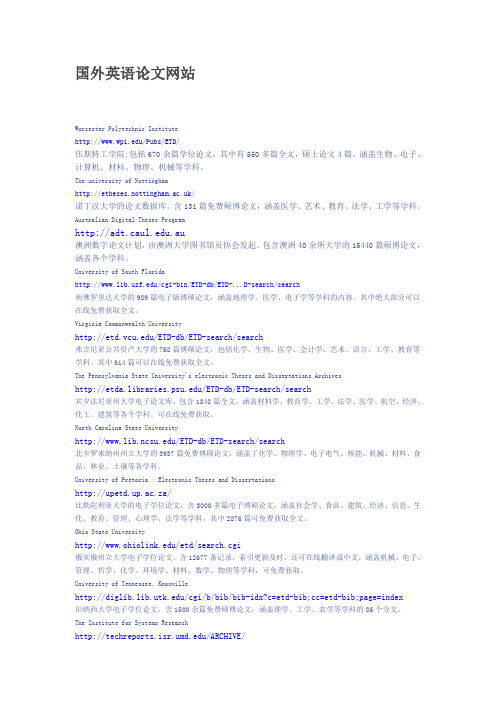
国外英语论文网站Worcester Polytechnic Institute/Pubs/ETD/伍斯特工学院:包括670余篇学位论文,其中有550多篇全文,硕士论文4篇。
涵盖生物、电子、计算机、材料、物理、机械等学科。
The university of Nottingham/诺丁汉大学的论文数据库。
含131篇免费硕博论文,涵盖医学、艺术、教育、法学、工学等学科。
Australian Digital Theses Program.au澳洲数字论文计划,由澳洲大学图书馆员协会发起。
包含澳洲40余所大学的15440篇硕博论文,涵盖各个学科。
University of South Florida/cgi-bin/ETD-db/ETD-...D-search/search南佛罗里达大学的989篇电子版博硕论文,涵盖地理学、医学、电子学等学科的内容。
其中绝大部分可以在线免费获取全文。
Virginia Commonwealth University/ETD-db/ETD-search/search弗吉尼亚公共资产大学的768篇博硕论文,包括化学、生物、医学、会计学、艺术、语言、工学、教育等学科。
其中614篇可以在线免费获取全文。
The Pennsylvania State University's electronic Theses and Dissertations Archives/ETD-db/ETD-search/search宾夕法尼亚州大学电子论文库,包含1848篇全文,涵盖材料学、教育学、工学、法学、医学、航空、经济、化工、建筑等各个学科。
可在线免费获取。
North Carolina State University/ETD-db/ETD-search/search北卡罗来纳州州立大学的3937篇免费博硕论文,涵盖了化学、物理学、电子电气、核能、机械、材料、食品、林业、土壤等各学科。
University of Pretoria : Electronic Theses and Dissertationshttp://upetd.up.ac.za/比勒陀利亚大学的电子学位论文,含3000多篇电子博硕论文,涵盖社会学、食品、建筑、经济、信息、生化、教育、管理、心理学、法学等学科,其中2876篇可免费获取全文。
欧盟伊拉斯谟对外合作窗口项目—NDEM项目申请通知
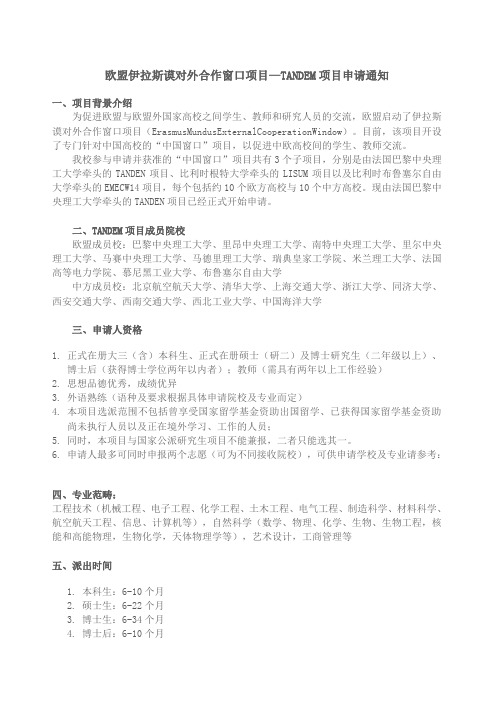
欧盟伊拉斯谟对外合作窗口项目—TANDEM项目申请通知一、项目背景介绍为促进欧盟与欧盟外国家高校之间学生、教师和研究人员的交流,欧盟启动了伊拉斯谟对外合作窗口项目(ErasmusMundusExternalCooperationWindow)。
目前,该项目开设了专门针对中国高校的“中国窗口”项目,以促进中欧高校间的学生、教师交流。
我校参与申请并获准的“中国窗口”项目共有3个子项目,分别是由法国巴黎中央理工大学牵头的TANDEN项目、比利时根特大学牵头的LISUM项目以及比利时布鲁塞尔自由大学牵头的EMECW14项目,每个包括约10个欧方高校与10个中方高校。
现由法国巴黎中央理工大学牵头的TANDEN项目已经正式开始申请。
二、TANDEM项目成员院校欧盟成员校:巴黎中央理工大学、里昂中央理工大学、南特中央理工大学、里尔中央理工大学、马赛中央理工大学、马德里理工大学、瑞典皇家工学院、米兰理工大学、法国高等电力学院、慕尼黑工业大学、布鲁塞尔自由大学中方成员校:北京航空航天大学、清华大学、上海交通大学、浙江大学、同济大学、西安交通大学、西南交通大学、西北工业大学、中国海洋大学三、申请人资格1.正式在册大三(含)本科生、正式在册硕士(研二)及博士研究生(二年级以上)、博士后(获得博士学位两年以内者);教师(需具有两年以上工作经验)2.思想品德优秀,成绩优异3.外语熟练(语种及要求根据具体申请院校及专业而定)4.本项目选派范围不包括曾享受国家留学基金资助出国留学、已获得国家留学基金资助尚未执行人员以及正在境外学习、工作的人员;5.同时,本项目与国家公派研究生项目不能兼报,二者只能选其一。
6.申请人最多可同时申报两个志愿(可为不同接收院校),可供申请学校及专业请参考:四、专业范畴:工程技术(机械工程、电子工程、化学工程、土木工程、电气工程、制造科学、材料科学、航空航天工程、信息、计算机等),自然科学(数学、物理、化学、生物、生物工程,核能和高能物理,生物化学,天体物理学等),艺术设计,工商管理等五、派出时间1.本科生:6-10个月2.硕士生:6-22个月3.博士生:6-34个月4.博士后:6-10个月5.教师:1-3个月6个月及以下的项目2010年春季派出,1学年及以上的项目2010年秋季派出。
安特卫普大学(UA)安特卫普大学管理学院(UAMS)

市缔结了友好城市关系
对华教学、科研合作项目
科研
• 从上世纪90年代开始,就和中国、澳门及东欧转型经济 国家的大学及研究机构合作
- 中国合作院校有:复旦、同济、南开,武大、川大、社科院 欧洲研究所、浦东干部管理学院等
• 合作伙伴: 大学或政府部门
• 专业:
工商管理 (MBA) (全日制) 、高级管理人员工商管 理 (EMBA)(在职) 、公共管理 (MPA) 、银行管理、 计算机审计、电子商务管理、房地产管理、个人财 政规划、文化管理
• 案例:
复旦大 学时: 脱产2-3个月(可另外安排政府部门和企业实习) • 文凭: 安特卫普大学学位课程结业证书 • 招生对象:政府公务员或企业管理人员 • 入学条件:大学本科毕业、有相关工作经历、有一定
• 案例:
西安交通大学管理学院/国际经营管理硕士项目
硕士学位 (要求工作经历)
• 学时:
不脱产2年或脱产1年
• 文凭:
比利时政府认可的硕士学位
• 招生对象: 政府公务员或企业管理人员
• 入学条件: 大学本科毕业、有3-4年工作经历、良好的 英语听、说、写水平(参加面试合格者)
• 授课地点: 中国/比利时
• 科研内容涉及中国国企改革、中国企业海外投资、跨国 公司战略、合资企业管理等
• 参加欧盟项目
- 中欧高等教育合作项目 - 欧盟-亚洲连接项目
• 为企业进入欧盟市场提供下列咨询服务:
- 市场调查/产品定位/竞争力分析 - 销售、服务商选择、合作企业资信调查 - 投资环境分析/投资战略制定
• 为政府机构的欧洲事务提供咨询服务
澳洲留学名校阿德雷德大学

澳洲留学名校阿德雷德⼤学学校名称:所在位置:澳洲,The University of Adelaide,Adelaide,South Australia 5005学费:31000 澳币录取率:0.601学校中⽂⺴址: 店铺⼩编为⼤家介绍澳洲留学名校阿德雷德⼤学,希望对店铺的同学有所帮助。
想了解更多留学精彩内容,店铺为你详细解答。
阿德雷德⼤学位于澳⼤利亚南部阿德雷德市,⾃1874年创校以来,阿德莱德⼤学⼀直位居澳⼤利亚顶尖⼤学之列。
截⾄2008年,阿德雷德⼤学曾培养出5个诺⻉尔奖和101个罗德奖的获得者。
阿德雷德⼤学现有19,000多名学⽣,其中包括来⾃88个国家的3,500名国际学⽣,分别就读于阿德雷得⼤学“北特⾥斯”、“罗斯沃斯”、“怀特”、“费巴顿”四个校区。
2010年美国《美国新闻和世界报道》(USNWR),和英国QS最新世界排名103。
1、学校简介 阿德雷德⼤学始建于1874年,位于澳⼤利亚的南部。
阿德雷德⼤学在各⽅捐赠下创办⽽成,是澳⼤利亚第三所最古⽼的⼤学。
⼀个多世纪以来,阿德雷德⼤学的教师,科研⼈员和毕业⽣为学校做出了突出的贡献。
涉及领域包括科学,医学,⼯程,法律,社会科学和艺术表演等⽅⾯。
阿德雷德⼤学有着优良的传统---创新和⾼质量的科研以及优秀的教学都为学⽣的学习提供保证。
该校发展国际化并且进⼀步提升师资⼒量,同时也创造更多的企业化机会。
阿德雷德⼤学还有着很好的学术环境,是⼀个和睦的团体。
阿德莱德⼤学(University of Adelaide)把传统的优势和现代艺术特⾊及丰富的学⽣⽣活相结合,是澳⼤利亚政府对⼤学⽣综合测评后推举的最优秀的四所⼤学之⼀。
是2010年世界排名73的⼤学,同时也是澳⼤利亚的澳洲⼋⼤名校之⼀,2010-2011澳洲⼤学排名第四(泰晤⼠报⾼等教育排名)。
位于南澳洲⾸府阿德莱德市中⼼。
澳⼤利亚⼀共得9名诺⻉尔奖获得者中,有5位来⾃阿德莱德⼤学。
在校⽣有20,088⼈,员⼯3,654⼈,其中包括5597多来⾃世界各地80多个国家的留学⽣就读于阿德莱德⼤学[2]。
范德堡细胞技术研究中心(深圳)有限公司介绍企业发展分析报告

Enterprise Development专业品质权威Analysis Report企业发展分析报告范德堡细胞技术研究中心(深圳)有限公司免责声明:本报告通过对该企业公开数据进行分析生成,并不完全代表我方对该企业的意见,如有错误请及时联系;本报告出于对企业发展研究目的产生,仅供参考,在任何情况下,使用本报告所引起的一切后果,我方不承担任何责任:本报告不得用于一切商业用途,如需引用或合作,请与我方联系:范德堡细胞技术研究中心(深圳)有限公司1企业发展分析结果1.1 企业发展指数得分企业发展指数得分范德堡细胞技术研究中心(深圳)有限公司综合得分说明:企业发展指数根据企业规模、企业创新、企业风险、企业活力四个维度对企业发展情况进行评价。
该企业的综合评价得分需要您得到该公司授权后,我们将协助您分析给出。
1.2 企业画像类别内容行业研究和试验发展-医学研究和试验发展资质空产品服务是:细胞技术研发和应用;技术服务、技术开1.3 发展历程2工商2.1工商信息2.2工商变更2.3股东结构2.4主要人员2.5分支机构2.6对外投资2.7企业年报2.8股权出质2.9动产抵押2.10司法协助2.11清算2.12注销3投融资3.1融资历史3.2投资事件3.3核心团队3.4企业业务4企业信用4.1企业信用4.2行政许可-工商局4.3行政处罚-信用中国4.4行政处罚-工商局4.5税务评级4.6税务处罚4.7经营异常4.8经营异常-工商局4.9采购不良行为4.10产品抽查4.11产品抽查-工商局4.12欠税公告4.13环保处罚4.14被执行人5司法文书5.1法律诉讼(当事人)5.2法律诉讼(相关人)5.3开庭公告5.4被执行人5.5法院公告5.6破产暂无破产数据6企业资质6.1资质许可6.2人员资质6.3产品许可6.4特殊许可7知识产权7.1商标信息最多显示100条记录,如需更多信息请到企业大数据平台查询7.2专利7.3软件著作权7.4作品著作权7.5网站备案7.6应用APP7.7微信公众号8招标中标8.1政府招标8.2政府中标8.3央企招标8.4央企中标9标准9.1国家标准9.2行业标准9.3团体标准9.4地方标准10成果奖励10.1国家奖励10.2省部奖励10.3社会奖励10.4科技成果11 土地11.1大块土地出让11.2出让公告11.3土地抵押11.4地块公示11.5大企业购地11.6土地出租11.7土地结果11.8土地转让12基金12.1国家自然基金12.2国家自然基金成果12.3国家社科基金13招聘13.1招聘信息感谢阅读:感谢您耐心地阅读这份企业调查分析报告。
- 1、下载文档前请自行甄别文档内容的完整性,平台不提供额外的编辑、内容补充、找答案等附加服务。
- 2、"仅部分预览"的文档,不可在线预览部分如存在完整性等问题,可反馈申请退款(可完整预览的文档不适用该条件!)。
- 3、如文档侵犯您的权益,请联系客服反馈,我们会尽快为您处理(人工客服工作时间:9:00-18:30)。
Estonian Excellence Centre of Dependable Computing(2003-2007)Research Team:Design and Test of Digital Systems (DT)EngineeringDepartmentComputerLeader of the research team:Raimund-Johannes Ubar, DSc, professor, Dept. of Computer Engineering, TTURaja 15, 12618 TallinnPhone: +372 620 2252Fax: +372 620 2253e-mail: raiub@pld.ttu.eehttp://www.pld.ttu.ee/~raiub/Senior staff of the team: P. Ellervee (assoc. prof., CE/TTU), M. Kruus (assoc. prof., CE/TTU), J. Raik (sen. res., CE/TTU), K. Tammemäe (assoc. prof., CE/TTU), A. Sudnitsõn (assoc. prof., CE/TTU), M. Tombak (prof., CS/UT), R.-J. Ubar (team leader, prof., CE/TTU).Research fields: The scientific goals of the DT research group are closely related to the most highly recognized guidelines for design and test solutions of “The MEDEA Design Automation Roadmap”. MEDEA (Micro-Electronics Development for European Applications) is a part of the pan-European EUREKA network for cooperative R&D in computer-aided design (CAD) and design automation. The team is involved in the following research fields: design and test of digital systems, self-testing and fault tolerance. The main target of the research is: to develop new efficient methods for modeling, design and test of digital systems to quarantee the efficiency, high quality and fault tolerance of systems in the conditions of continuously increasing complexities. To reach this target the team has competence, and is actively working with the following more specific problems: diagnostic models for digital systems, automatization of test program generation, fault simulation and fault diagnosis in digital systems, physical defect oriented fault analysis, decompositional design and design error diagnosis in digital systems, analysis and partitioning methods for hardware/software codesign, and development of unified representation of systems for control and memory intensive applications.Most important results of the recent years:Systems modeling and synthesis. Design/synthesis. Prototype high-level synthesis tool targeting control and memory intensive applications has been developed [1]. The tool makes efficient use of commercial logic synthesis tools thus allowing designers to start with design entry from higher abstraction levels [2]. In the field of emulation, an accelerator for fault simulation based on reconfigurable hardware (FPGAs) was developed with a novel method for fault injection [3-5]. The experimental research demonstrated very high speed in fault simulation of sequential circuits. Compared to software based solutions the speed increased more than 200 times. Experiments also showed that it is beneficial to use emulation for circuits/methods that require large numbers of test vectors, e.g. simulation-based test pattern generation or validation.Diagnostic modeling. The recent activities of the research group have been related to the fundamental research on mathematical models for diagnostic simulation of digital systems and application research in the field of hierarchical test generation and fault simulation of digital systems. In this field of basic research, the department had a pioneering position in the world with introducing the SSBDDs for the logic level, and generalizing the BDDs for using at higher level abstractions of digital systems [6-17].The main difference of SSBDDs compared to the traditional BDDs [18] is in the novelty of representing the structure along the functions [19,20]. A uniform multi-level model for digital systems based on DDs as an extension and generalization of the BDDs has been also developed by the group [19,21]. The DD model allowed us to develop efficient methods for simulating digital systems in a very fast way by uniform algorithms at different logic, RTL, ISA or behavioral levels [20-22]. Promising results have been obtained by SSBDDs in delay simulation [23], design error diagnosis [24,25], fault simulation [26,27], and in jointly using SSBDDs and high-level DDs for hierarchical ATPGs [28-30].Verification and debug. The research group has participated in verification related research in the framework of European 6th FP STREP project VERTIGO (2006-2008) and in the national Development Center programme (2004-2007). The international research partners include universities of Verona, Southampton and Linköping. As a result of these projects, High-level Decision Diagram (HLDD) based modeling forverification of register-transfer and system level digital systems has been developed [31]. Efficient methodsfor code coverage analysis and assertion checking [32] using HLDDs have been introduced. In the field of design error diagnosis, a new conception and method was developed, which allows to adopt in a straightforward way the methods and tools of fault diagnosis used in hardware testing for the use in design error diagnosis [33,34]. A new approach for design error diagnosis was developed that does not exploit error models [24,25].Test generation. A new approach to defect-oriented fault simulation has been developed, based on mapping the physical defects into higher level constraints [35,36]. The first time, a method and tool were created for proving redundancy of physical defects, which allows to evaluate the quality of tests more adequately compared to existing tools [36-39]. The new functional fault model creates a simple conception and basis for hierarchical defect oriented test [35,36].The results in testing SoC and NoC can be classified as: (1) solving the test application and fault detection problem in GALS structures [40] and (2) design of a reconfigurable embedded test generation solution that supports a trade-off between test speed and test quality and is designed for multi-layer on-chip interconnect structures [41]. Both methods target delay and crosstalk faults. A novel Boundary Scan-like BIST conceptionfor autonomous at-speed testing and diagnosis of interconnects was developed [42-44]. The new paradigm brings a never achieved before high level of universality, scalability, and configuration independence into theat-speed interconnect testing and diagnosis of interconnect.Most of the previously published NoC test methods are relying on scan-based approaches. In [45,46] the research group proposed an external well scalable test approach that is based on deriving test configurations from functional fault models for the crossbar switch. A new generalized approach to testability calculation was developed [29,47]. Based on the testability guidance, a very fast RT-level ATPG DECIDER [28] has been developed.Design for testability. In self-test, a close cooperation between TTU and Linköping University, Sweden has given several original results in the area of hybrid BIST. The results have been reported in many high-quality conferences, like DFT, ATS, ETS [48], and in 2 book chapters [55,56]. The new results achieved by the group can be formulated as follows: (1) A novel method for fast cost estimation for variations of test processes with complex structure [48,49]. (2) Based of the fast cost estimation method, very efficient iterative methods were developed for optimizing hybrid sequential and parallel test processes at different constraints [50-53]. A conception and implementation of a hybrid functional BIST was proposed that allows to reduce considerably the hardware cost compared to the traditional BIST methods [54].Efficient new methods were developed which allow to use BIST for embedded diagnosis purposes [57,58]. The main idea of the methods is based on bisectioning the fault lists instead of bisectioning the test patterns.A considerable increase of speed and resolution of diagnosis was achieved.Design for dependability. Research results have been published till now mainly in the field of fault injection with purposes of evaluation of the dependability of systems. New hierarchical multi-level techniques for malicious fault list generation for evaluating the fault tolerance is presented [59-61]. The methods are basedon using high and low level DDs. Malicious faults are found by top-down technique, keeping the complexityof candidate fault sets at each level as low as possible.Defended dissertations. Over the last ten years 14 dissertations have been defended in the project’s research field (which surpasses the number of people in the research staff): Tammemäe, Dushina, Ellervee, Raik, Brik, Astrova, Jutman, Vaarandi, Fomina, Jervan, Ivask, Lepmets, Listak, Orasson. Six of them was supervised by PI. In the proposed project 15 PhD students will be involved. Two of them (H.Kruus and S.Devadze) have planned to defend the thesis in 2008.References:1. P. Ellervee. xTractor: An Academic High-Level Synthesis Tool for Control and Memory IntensiveApplications. The 20th NORCHIP Conference, Copenhagen, Denmark, pp.253-258, Nov. 2002.2. P. Ellervee, E. Ivask, M. Kruus. Improved VHDL Input for High-Level Synthesis Tool xTractor. The 10thBiennial Baltic Electronic Conference (BEC'2006), Tallinn, Estonia, pp.87-90, Oct. 2006.3. P.Ellervee, J.Raik, V.Tihhomirov, R.Ubar. FPGA Based Fault Emulation of Synchronous Sequential Circuits.Proc. of the 22nd IEEE Norchip Conference, Oslo, November 8-9, 2004, pp.59-62.4. J.Raik, P.Ellervee, V.Tihhomirov, R.Ubar. Improved Fault Emulation for Synchronous Sequential Circuits.IEEE Proceedings of the 8th Euromicro conference on Digital Systems Design DSD2005. Porto, Aug.30 – Sept. 3, 2005, pp.72-78.5. P.Ellervee, J.Raik, K.Tammemäe, R.-J.Ubar. FPGA Based Fault Emulation of Synchronous SequentialCircuits. IET Computers & Digital Techniques, Volume 1, Issue 2, pp.70-76, March 2007.6. R.Ubar. Test Synthesis with Alternative Graphs. IEEE Design and Test of Computers. Spring, 1996, pp.48-59.7. R.Ubar. Multi-Valued Simulation of Digital Circuits with Structurally Synthesized Binary DecisionDiagrams. OPA (Overseas Publishers Assotiation) N.V. Gordon and Breach Publishers, J. of Multiple Valued Logic, Vol.4 pp. 141-157, 1998.8. R.Ubar, A.Moraviec, J.Raik. Cycle-based Simulation with Decision Diagrams. IEEE Proc. of DesignAutomation and Test in Europe - DATE. Munich, March 9-12, 1999, pp.454-458.9. R.Ubar, A.Morawiec, J.Raik. Back-Tracing and Event-Driven Techniques in High-Level Simulation withDecision Diagrams. Proc. of the IEEE ISCAS’2000 Conference, Geneva, May 28-31, 2000, Vol. 1, pp. 208-211.10. R.Ubar, D.Borrione. Design Error Diagnosis in Digital Circuits without Error Model. In VLSI: Systems onChip, Kluwer Academic Publishers, 2000, pp.281-292.11. J.Raik, R.Ubar. Fast Test Pattern Generation for Sequential Circuits Using Decision DiagramRepresentations. J. of Electronic Testing: Theory and Applications - JETTA. Kluwer Academic Publishers, Vol. 16, No. 3, pp. 213-226, 2000.12. A.Jutman, R.Ubar, Z.Peng. Algorithms for Speeding-Up Timing Simulation of Digital Circuits. DATE,Munich, March 13-16, 2001, pp.460-465.13. R.Ubar. Design Error Diagnosis with Resynthesis in Combinational Circuits. J. of Electronic Testing: Theoryand Applications - JETTA. Kluwer Academic Publishers, Vol.19, No.1, pp.73-82, 2003.14. J.Raik, R.Ubar, S.Devadze, A.Jutman. Efficient Single-Pattern Fault Simulation on Structurally SynthesizedBDDs. Lecture Notes in Computer Science, Vol. 3463, Springer Verlag, Berlin, Heidelberg, New York 2005, pp. 332-344.15. J.Raik, T.Nõmmeots, R.Ubar. A New Testability Calculation Method to Guide RTL Test Generation. Journalof Electronic Testing: Theory and Applications – JETTA. Springer Science + Business Media, Inc. 21, pp.73-84, 200516. J.Raik, R.Ubar, T.Viilukas. High-Level Decision Diagram based Fault Models for Targeting FSMs.Proceedings of the 9th IEEE Euromicro Conference on Digital Systems Design DSD2006, Cavtat, pp. 353-358, Aug. 31 - Sep. 2, 2006.17. R.Ubar, S.Devadze, J.Raik, A.Jutman. Ultra-Fast Parallel Fault Analysis on Structural BDDs. European TestSymposion, Freiburg, May 20-23, 2007.18. R.E.Bryant. Graph-based algorithms for Boolean function manipulation. IEEE Trans. on Computers,Vol.C-35, No8, 1986, pp.667-690.19. R.Ubar. Test Synthesis with Alternative Graphs. IEEE Design and Test of Computers. Spring, 1996, pp.48-59.20. R.Ubar. Multi-Valued Simulation of Digital Circuits with Structurally Synthesized Binary DecisionDiagrams. OPA (Overseas Publishers Assotiation) N.V. Gordon and Breach Publishers, J. of Multiple Valued Logic, Vol.4 pp. 141-157, 1998.21. R.Ubar, A.Moraviec, J.Raik. Cycle-based Simulation with Decision Diagrams. IEEE Proc. of DesignAutomation and Test in Europe - DATE. Munich, March 9-12, 1999, pp.454-458.22. R.Ubar, A.Morawiec, J.Raik. Back-Tracing and Event-Driven Techniques in High-Level Simulation withDecision Diagrams. Proc. of the IEEE ISCAS’2000 Conference, Geneva, May 28-31, 2000, Vol. 1, pp. 208-211.23. A.Jutman, R.Ubar, Z.Peng. Algorithms for Speeding-Up Timing Simulation of Digital Circuits. DATE,Munich, March 13-16, 2001, pp.460-465.24. R.Ubar, D.Borrione. Design Error Diagnosis in Digital Circuits without Error Model. In VLSI: Systems onChip, Kluwer Academic Publishers, 2000, pp.281-292.25. R.Ubar. Design Error Diagnosis with Resynthesis in Combinational Circuits. J. of Electronic Testing: Theoryand Applications - JETTA. Kluwer Academic Publishers, Vol.19, No.1, pp.73-82, 2003.26. J.Raik, R.Ubar, S.Devadze, A.Jutman. Efficient Single-Pattern Fault Simulation on Structurally SynthesizedBDDs. Lecture Notes in Computer Science, Vol. 3463, Springer Verlag, Berlin, Heidelberg, New York 2005, pp. 332-344.27. R.Ubar, S.Devadze, J.Raik, A.Jutman. Ultra-Fast Parallel Fault Analysis on Structural BDDs. European TestSymposion, Freiburg, May 20-23, 2007.28. J.Raik, R.Ubar. Fast Test Pattern Generation for Sequential Circuits Using Decision DiagramRepresentations. J. of Electronic Testing: Theory and Applications - JETTA. Kluwer Academic Publishers, Vol. 16, No. 3, pp. 213-226, 2000.29. J.Raik, T.Nõmmeots, R.Ubar. A New Testability Calculation Method to Guide RTL Test Generation. Journalof Electronic Testing: Theory and Applications – JETTA. Springer Science + Business Media, Inc. 21, pp.73-84, 200530. J.Raik, R.Ubar, T.Viilukas. High-Level Decision Diagram based Fault Models for Targeting FSMs.Proceedings of the 9th IEEE Euromicro Conference on Digital Systems Design DSD2006, Cavtat, pp. 353-358, Aug. 31 - Sep. 2, 2006.31. J.Raik, R.Ubar, T.Viilukas, M.Jenihhin. Mixed Hierarchical-Functional Fault Models for TargetingSequential Cores. Elsevier Journal of Systems Architecture (accepted for publication)32. M.Jenihhin J.Raik, A.Chepurov, R.Ubar. Assertion Checking with PSL and High-Level Decision Diagrams.Proceedings of the IEEE 8th Workshop on RTL and High Level Testing - WRTLT'07. IEEE Computer Society Press, 2007.33. R.Ubar, D.Borrione. Single Gate Design Error Diagnosis in Combinational Circuits. Proceedings of theEstonian Acad. of Sci. Engng, 1999, Vol. 5 , No 1, pp.3-21.34. R.Ubar, A.Jutman. Design Error Localization in Digital Circuits by Stuck-at Fault Test Patterns. IEEE 22ndInt. Conference on Microelectronics, Nis, Yugoslavia, May 14-17 2000, pp.723-726.35. R.Ubar, W.Kuzmicz, W.Pleskacz, J.Raik. Defect-Oriented Fault Simulation and Test Generation in DigitalCircuits. 2nd Int. Symp. on Quality of Electronic Design – ISQED, San Jose, California, March 26-28, 2001, pp.365-371.36. T.Cibáková, M.Fischerová, E.Gramatová, W.Kuzmicz, W.Pleskacz, J.Raik, R.Ubar. Hierarchical TestGeneration for Combinational Circuits with Real Defects Coverage. Pergamon Press. Journal ofMicroelectronics Reliability, Vol. 42, 2002, pp.1141-1149.37. J.Raik, R.Ubar, J.Sudbrock, W.Kuzmicz, W.Pleskacz. DOT: New Deterministic Defect-Oriented ATPG Tool.Proc. of 10th IEEE European Test Symposium, May 22-25, 2005, Tallinn, pp.96-101.38. J.Sudbrock, J.Raik, R.Ubar, W.Kuzmicz, W.Pleskacz. Defect-Oriented Test- and Layout-Generation forStandard-Cell ASIC Designs. Proceedings of the 8th Euromicro conference on Digital Systems DesignDSD2005. Porto, Aug.30 – Sept. 3, 2005, pp.79-82.39. R.Ubar, M.Aarna, H.Kruus, J.Raik. How to Generate High Quality Tests for Digital Systems. IEEEInternational Semiconductor Conference, CAS’2004, Sinaia, Romania, Oct. 4-6, 2004, pp.459-462.40. T.Bengtsson, A.Jutman, S.Kumar, R.Ubar. Delay Testing of Asynchronous NOC Interconnects. Proceedingsof the 12th International Conference Mixed Design of Integrated Circuits and Systems Kraków, 22-25 June 2005, pp.419-424.41. T.Bengtsson, A.Jutman, R.Ubar, S.Kumar. A method for crosstalk fault detection in on-chip Buses. IEEENORCHIP Conference, Oulu, Finland, Nov. 21-22, 2005.42. A.Jutman. Efficient At-Speed Interconnect BIST and Diagnosis Framework. Informal Digest of Papers of10th IEEE European Test Symposium (ETS’05), Tallinn, Estonia, May 22-25, 2005, pp. 257-258.43. A. Jutman, “At-Speed BIST for Board-Level Interconnect”, IEEE European Board Test Workshop, Tallinn,Estonia, 25–26 May, 2005.44. A.Jutman, R.Ubar, J.Raik. New Built-In Self-Test Scheme for SoC Interconnect. Proceedings of the 9thWorld Multi-Conference on Systemics, Cybernetics and Informatics. July 10-13, 2005, Orlando, Florida, USA, vol.4, pp.19-24.45. J.Raik, ind, R.Ubar. An External Test Approach for Network-on-a-Chip Switches. Proceedings of theIEEE Asian Test Symposium 2006, Fukuoka, Japan, pp. 437-442, Nov. 2006.46. J.Raik, R.Ubar, ind. Test Configurations for Diagnosing Faulty Links in NoC Switches. Proc. of the12th IEEE European Test Symposium, Freiburg, Germany, May 20-24, 2007.47. J.Raik, ind, R.Ubar. RT-Level Test Point Insertion for Sequential Circuits. Proc. of the IEEE 1stInternational Workshop on Testability Assessment – IWoTA-2004, Rennes, Nov.2, 2004, pp.34-40.48. R.Ubar, M.Jenihhin, G.Jervan, Z.Peng. Hybrid BIST Optimization for Core-Based Systems with Test PatternBroadcasting. 2nd IEEE Int. Workshop on Electronic Design, Test and Applications – DELTA’04, Perth, Australia, 28-30 January 2004, pp.3-8.49. G.Jervan, Z.Peng, R.Ubar, O.Korelina. An Improved Estimation Methodology for Hybrid BIST CostCalculation. Proc. of the 22nd IEEE Norchip Conference, Oslo, November 8-9, 2004, pp.297-300.50. G.Jervan, Z.Peng, T.Shchenova, R.Ubar. A Hybrid BIST Energy Minimization Technique for SoC Testing.IEE Proceedings on Computers & Digital Techniques, July 2006, Vol. 153, Issue 4, pp.208-216.51. G.Jervan, P.Eles, Z.Peng, R.Ubar, M.Jenihhin. Test Time Minimization for Hybrid BIST of Core-BasedSystems. J. of Computer Science and Technology. Nov. 2006, Vol. 21, No. 6, pp. 907-912.52. R.Ubar, T.Shchenova, G.Jervan, Z.Peng. Energy Minimization for Hybrid BIST in a System-on-Chip TestEnvironment. Proc. of 10th IEEE European Test Symposium, May 22-25, 2005, Tallinn, pp.2-7.53. G.Jervan, P.Eles, Z.Peng, R.Ubar, M.Jenihhin. Hybrid BIST Time Minimization for Core-Based Systemswith STUMPS Architecture. 18th Int. Symposium on Defect and Fault Tolerance in VLSI Systems.Cambridge, MA, USA, November 3-5, 2003.54. R.Ubar, N.Mazurova, J.Smahtina, E.Orasson, J.Raik. HyFBIST: Hybrid Functional Built-In Self-Test inMicroprogrammed Data-Paths of Digital Systems. Int. Conference MIXDES, Szczecin, June 24-26, 2004, pp.497-502.55. G.Jervan, R.Ubar, Z.Peng, P.Eles. Test Generation: A Hierarchical Approach. In “System-level Test andValidation of Hardware/Software Systems” by M.Sonza Reorda, Z.Peng, M.Violante. Springer Series in Advanced Microelectronics, Vol.17, 2005, pp. 63-77.56. G.Jervan, R.Ubar, Z.Peng, P.Eles. An Approach to System Level Design for Testability. In “System-levelTest and Validation of Hardware/Software Systems” by M.Sonza Reorda, Z.Peng, M.Violante. Springer Series in Advanced Microelectronics, Vol.17, 2005, pp. 91-118.57. R.Ubar, S.Kostin, J.Raik, T.Evartson, H.Lensen. Fault Diagnosis in Integrated Circuits with BIST. Proc. of10th EUROMICRO Conference on Digital System Design - DSD 2007, Lübeck, Germany, August 27 - 31, 2007.58. R.Ubar, S.Kostin, J.Raik, M.Kruus. Experimental Comparison of Different Diagnosis Algorithms in the BISTEnvironment. IASTED Conference on Applied Simulation and Modelling - ASM 2007. Palma de Mallorca, August 29-31, 2007.59. A. Benso, P.Prinetto, M.Rebaudengo, M.Sonza, R.Ubar. A New Approach to Build a Low-Level MaliciousFault List Starting from High-Level Description and Alternative Graphs. Proc. IEEE European Design & Test Conference, Paris, March 17-20, 1997, pp.560-565.60. A.Benso, P.Prinetto, M.Rebaudengo, M.Sonza Reorda, J.Raik, R.Ubar. Exploiting High-Level Descriptionsfor Circuits Fault Tolerance Assessments. 1997 IEEE International Symposium on Defect and FaultTolerance in VLSI Systems. Paris, October 20-22, 1997, pp. 212-216.61. R.Ubar, G.Jervan, J.Raik, M.Jenihhin, P.Ellervee. Dependability Evaluation in Fault-Tolerant Systems withHigh-Level Decision Diagrams. Proceedings of IWK, Ilmenau, September 10.13, 2007.。
